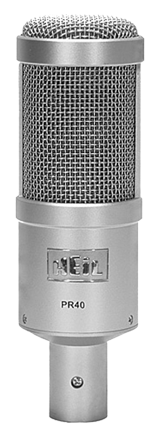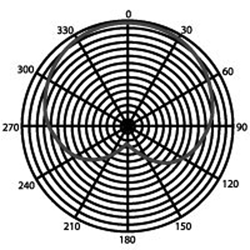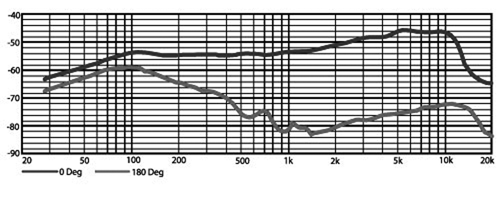by Steve Cunningham
This month brings us a two-fer, consisting of two products I recently installed for a voice actor as part of a home studio refurbishment.
This individual already had a suitable notebook PC running Adobe Audition 3 on XP, using an inexpensive USB audio interface to capture the sound from a Chinese-built large diaphragm condenser microphone.
He told me he felt his room just “wasn’t working” as well as he’d like, so I set about performing general maintenance on his computer and the signal path.
I had just finished tuning his room, when he announced that he’d like to replace his microphone with something that was a little “warmer” sounding. Then he mentioned that Leo Laporte uses a mic that he’d like to try, which turns out to be Heil PR40 dynamic microphone. This beast has been around for almost four years, and has become a standard amongst broadcasters and podcasters, giving the Electrovoice RE-20 and -27 a good run for their money. It so happens I’d requested an eval unit a little while ago -- perfect timing.
He also allowed as how he’d like a better preamp than the one in his USB interface, preferably one with EQ and compression built-in, but at a budget price. I’ve had my eye on a relatively new entry from Presonus, the Studio Channel, that seemed to fit the bill. A couple of phone calls and we had one available for an evaluation (and of course, a RAP column!). Let’s have a look.
 HEIL PR40
HEIL PR40
Although it looks like a large-capsule condenser mic, behind the deceptive exterior lies an end-address dynamic mic that’s designed for voicework (as well as musical instruments). Given its physical attributes and extended low-end response (see the frequency plot), the PR40 will probably be compared with the aforementioned RE-20 and -27, although it has some characteristics of the Sennheiser MD421 as well. Either way, you know that if Bob Heil is involved in the design, what’s underneath will definitely be different. Bob Heil is both a ham radio enthusiast and a sound reinforcement expert with an impressive track record. In the early ’70s he set up the legendary “wall of sound” PA for the Grateful Dead, and his “Talk Box” created the talking guitar made famous by Peter Frampton. He’s since been involved with communications microphones, so he knows whereof he speaks when it comes to designing mics with precise polar patterns.
The microphone is assembled and tested at Heil Sound’s facility in Illinois from components made in the UK, Malaysia, Japan, China and Taiwan. It has a surprisingly wide frequency range for a dynamic microphone, covering 28Hz to 18kHz (-3dB). It’s designed to handle high sound pressure levels, but manages to sound more natural on voice than most cardioid dynamic mics, many of which have a colored sound due to the complex porting used to create their cardioid pattern. Although the frequency response is nominally flat between the upper and lower roll-off points, there is a very slight presence bump around 4 kHz, which gives a sense of air at the top end.
 Heil’s approach to cardioid dynamic mics produces a tight polar pattern, with very high rear-rejection (see the polar plot). A 1.125- inch, low-mass diaphragm is combined with a neodymium magnet structure for a magnetic field that Heil claims is 10 times stronger than the traditional magnets in other microphones. Aluminum is used for the humbucking voice coil to reduce interference from nearby electronics, which means you can use the PR40 near CRT monitors and the like without fear of hum. Bass-boost from proximity effect has been minimized, as much as one can with a cardioid-pattern pressure gradient microphone.
Heil’s approach to cardioid dynamic mics produces a tight polar pattern, with very high rear-rejection (see the polar plot). A 1.125- inch, low-mass diaphragm is combined with a neodymium magnet structure for a magnetic field that Heil claims is 10 times stronger than the traditional magnets in other microphones. Aluminum is used for the humbucking voice coil to reduce interference from nearby electronics, which means you can use the PR40 near CRT monitors and the like without fear of hum. Bass-boost from proximity effect has been minimized, as much as one can with a cardioid-pattern pressure gradient microphone.

The pop screen consists of two wire-mesh screens, along with what Heil describes as an internal filter. It does, however, keep popping to a minimum when the mic is used for VO work, and also helps avoid sibilance. The steel body is plated in a good-looking satin finish, and the XLR is at the back end where you’d expect it. The mic comes with a swivel mount (an optional spyder shock mount is available), and the whole business comes in a compact, foam-lined aluminum case.
WORKING THE MIC
I like dynamics for voiceover work, as they seem to me to have an immediacy that is lacking in many condenser mics. Perhaps it’s the fact that dynamics don’t always pick up every viscous sound coming from the actor’s mouth, or the in-your-face midrange that most of them possess. The PR40 has the latter, but is much more natural sounding than even an SM-7, likely due to the presence boost. There’s plenty of low-end available for the big voice guy, although the overall volume level does increase markedly with decreasing distance from the mic.
The mic’s susceptibility to popping is impressively low, given the extended bass response, but I’d still recommend using a low-cut filter and pop screen for VO work.
There’s really no comparison with the RE-20, although the RE-27, with its improved high-end response, is a fairer matchup. Still, the PR40 bears more than a passing resemblance to a condenser mic in terms of performance. In fact, it may be one of the best dynamics I’ve ever tried. No one who knows microphones is likely to mistake it for a good condenser, but it holds its own -- the lows and highs are not hyped, but they’re definitely present. Overall the frequency response feels almost flat, but not at all dull. It’s more of a vintage sound, strong in the mids, but not crowding out the entire frequency spectrum. Its self-noise is extremely low; a good thing, because it needs about 40 dB of preamp gain to get busy, but still about 10 dB less than what an RE-20 needs.
And let us not forget that dynamic mics are far less fragile than condensers, making the PR40 ideal for remote work and travel in general, although it is on the heavy side. Steve sez check it out. The Heil PR40 has a suggested list price of $325. For more information visit www.heilsound.com.
PRESONUS STUDIO CHANNEL

The PreSonus Studio Channel is an all-analog single channel strip consisting of a preamp, compressor, and EQ. It’s a full featured box that includes a high pass filter and the ability to swap the order of the EQ and compressor in the signal path. PreSonus has packed a lot of functionality into a very blue 1U package for a street price of around $300.
The front panel is divided into three basic sections. Leftmost is the tube preamplifier with knobs for gain and “tube drive.” Lighted buttons are provided for phantom power, phase, a -20 dB pad, and an 80 Hz low-cut filter. To the right of these is the compressor with the customary five-knob set for controlling threshold, ratio, attack and release, and gain. Buttons are provided to control soft knee on and off, auto makeup gain, setting the EQ to pre- or post-compressor, and metering. The center of the front panel is home to the very analog VU meter, which can be set to reflect input level or gain reduction by using the aforementioned metering button.
The right side of the front panel is home to the equalizer. EQ consists of low and high shelving filters with frequency and gain knobs, and these can be set to work as peak filters by hitting the associated button above the knobs. The mid-frequency equalizer is fully parametric, with knobs for frequency, gain, and Q. At the far right is a single level control, with a red LED overload indicator above it.
The rear panel is home to the single input, which is available as an XLR mic socket or a quarter inch TRS line level jack (these cannot be used simultaneously). Next to that is the single output, available on either XLR or TRS phone plug. On the left side you’ll find the power switch and the check for the included wall worked power supply.
GAS ON!
The preamp in the Studio Channel is a class A tube affair, and is not completely un-colored. Having said that, it’s not unpleasantly colored either, with a slightly forward sound in the 1 kHz region. Presonus claims that it produces 60 dB of gain, and the spec’d noise floor is a very respectable -96 dBu, although I would say that about 50 dB of the gain is truly usable clean gain, before a little bit of self-noise begins to creep in. The EIN is down at -126 dB, and claimed THD + Noise is less than 0.05%. These specs all look good, and provided my client leaves the tube drive at 0% he’ll get enough clean gain to handle a mic like the PR40 quite nicely. But for my client it has been a serious step up from the preamps in his USB interface.
I experimented with the tube drive a bit, and if you set the input gain high enough you will begin to get some of that tube-breakup sound. However, this is a starved tube design so the breakup is not nearly as pleasant as a vintage guitar amp. I think the tube drive is best used to add just the smallest amount of warmth to the sound, and otherwise left disabled.
The compressor is competent and able to nicely control peaks. It’s well-behaved and quiet, although you can get into some serious squash to a limited extent. The soft neat response works as expected, as does the auto makeup gain, which provides -10 dB to +10 dB of gain change. The attack control goes from 0.1 to 200 ms which is an adequate range. However, the release control can get a little squirrelly, since its range goes from 0.05 ms all the way up to 3 seconds.
Regarding the compressor settings, there was some confusion early on when PreSonus posted specs on their site that gave incorrect values for the available compression ratios. Following some creative feedback delivered by customers and potential customers, PreSonus corrected their error and posted the correct numbers. Available compression ratios range from unity (1:1) up to 10:1, which is considered essentially limiting.
Production professionals may find the equalizer somewhat limiting, with only one band of fully parametric EQ available. Further, the Q control on that parametric mid-band only narrows to 2.5, which is not exactly a surgical level of EQ. On the other hand, for a voice talent’s home studio this EQ may be a godsend, since he or she is less likely to do damage with limited equalization. The gain controls on all bands are limited to + or -10 DB, providing further safety in applications where simple sound shaping is all that’s necessary. For my client, this level of simple equalization, clean and quiet, is exactly what the doctor ordered.
At $300 on the street, the PreSonus Studio Channel is a well laid out channel strip that serves its purpose. I’m happy to report that my client is quite satisfied overall with his new setup. He tells me that his clients like his new microphone much better than the old one, which makes me wonder why he told them about it anyway, but there you have it. It even makes his old condenser sound better. And while the Studio Channel is not my first choice for a voiceover channel strip, the preamps are a significant step up from what he had, the compressor does its job nicely, and he can’t hurt himself with the EQ. It’s good value for the money, and that sounds like a win-win.
The PreSonus Channel Strip carries a suggested retail price of $359. For more information, visit www.presonus.com.
♦

